|
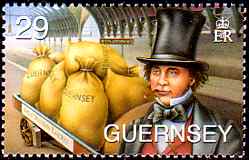
|
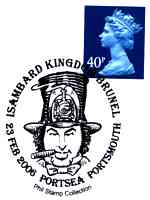
| |
Britain’s Isambard Kingdom Brunel (1806 - 1859) was an engineering genius in the service of the Great Western
Railway (GWR). He created railroad lines and stations, tunnels, bridges, harbour facilities, a 1000-bed pre-fabricated
hospital for the Crimean War, and constructed three famous ships.
Several commemorative stamps and postmarks are honoring his 200th birthday.
|

| |
These sketches shown in a British prestige booklet issued 2006 provide a size comparison. From left to right we see
the paddle-wheel steamer "Great Western", the screw-driven steamship "Great Britain", and the huge steamship
"Great Eastern".
|
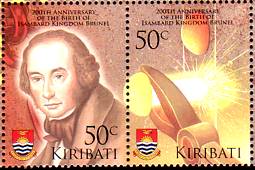
|
His first ship was still built with a traditional wooden hull. Thereafter, as seen on this stamp, iron plates joined by
red-hot rivets became Brunel's preferred construction material.
These iron plates held the "Great Britain" together for over 160 years until the present day. Also, these steel plates
made the "Great Eastern" scrapping take two years time!
|
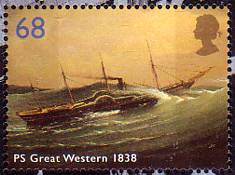
|
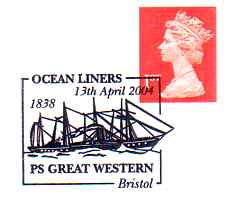
|
In 1835 Brunel proposed that the Great Western Railway should expand
its network westward beyond Bristol to New York, with a steamship! The directors agreed.
Thus construction of the "Great Western" began 1837 at the William Patterson Shipyard in Bristol.
Some data:
- L * B * T = 71,9m * 10,7m * 5,1m
- 1.340 grt, 2,300 net
- two steam engines with 225 HP rated output each
- two paddle side wheels, four masts with auxiliary sails
- Speed 8.5 to 9 kn,
- 128 1st class passengers, 20 in 2nd class
- Crew 57 men
|
|
During one of the first trial runs a steam boiler heated the frames around the funnel area so strongly that the captain
set the ship aground. However, damage was minor and the ship refloated with the next tide. Only 7 passengers
dared ride along for its first Atlantic passage — many were scared of this new mode of transportation. This first
passage also was to become an ocean race between the "Great
Western" and the smaller "Sirius", on time charter to the British & American Steam Navigation
Company. The "Great Western" won with an average speed of 8 kn and three days less than needed by the "Sirius"
(15:18).
|
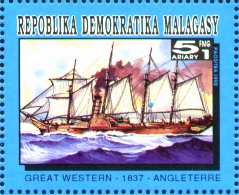
| |
Although nobody yet spoke of a "Blue Riband " at the time, the "Great Western" was the fastest ship on the North
Atlantic route.
|
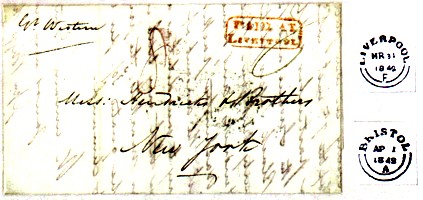
|
During the following 8 years the "Great Western" performed 67 crossings between Bristol and/or Liverpool and New
York, reliably and regularly, with average travel time of 12 to 15 days.
In 1846 the ship was sold to the Royal Steam Packet Company.
In 1855 she was requisitioned by the British authorities and used as a troop
transporter in the Crimean War. 1856/57 the ship was scrapped.
| |
This letter was carried aboard in 1842: with "Great Western" from
Liverpool and Bristol to New York, "Paid at Liverpool" with 8 pence and
6 cent ship fee in New York. The manuscript "8" and "6" are recognizable above
the address.
|
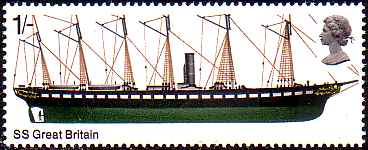
| |
In 1839 construction of the "Great Britain" began as wheel steamer "Mammoth". But due to the success of screw
steamer "Archimedes", Brunel radically changed the building plans. The ship was to become the first ocean-going
vessel with screw propulsion, and the first transatlantic ship built of iron. Other innovations were waterproof
transverse bulkheads, a double bottom, and a balanced rudder. She was renamed in "Great Britain".
|
Some data:
- Builders: William Patterson, Bristol
- 1839 keel-laying in the Great Western drydock
- 1843 floating-out
- L * B * T = 86,9m * 15,4m * 5,5m
- LOA 98,2m
- 3,443 BRT, 1,016 NRT,
- two steam engines, 2,000 HP
- a screw propeller of 4.7m diameter with six blades
- six masts with auxiliary sails
- Speed of 8.5 to 12 kn
- 360 1st class passengers
- Crew 130 men
|
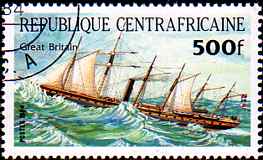
|
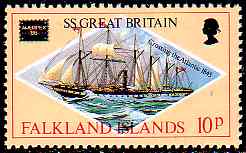
|
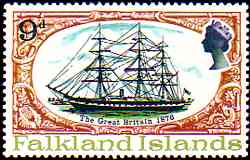
|
|
In June 1845 the "Great Britain" performed her maiden voyage from Liverpool to New York in 15 days. On following
trips there were a number of incidents: In a storm a mast broke, a propeller blade fell off, in 1846, on her fifth voyage,
she ran hard aground in Dundrum Bay near Belfast. About a year later she was salvaged and laid-up, then sold to
Gibbs & Bright in 1850. The ship was converted to a four-masted vessel with two side-by-side funnels, engines were
replaced, and interiors were modernized.
|
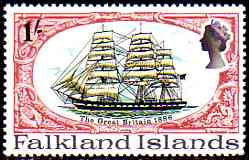
|
In 1852 she made her first voyage from Liverpool to Melbourne and Sydney with 636 emigrants and a full cargo of
freight. In 1853 she was re-rigged from a four-masted ship to a three-master with one funnel.
By 1875 "Great Britain" had made 32 trips to Australia, the fastest one in 54 days.
|
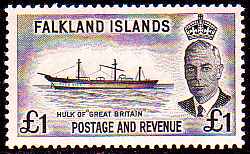
|
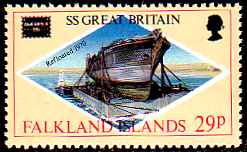
| |
In-between "Great Britain" was used as troop transporter, 1855/56 for the Crimean War and 1857/58 during the
Indian Mutiny.
The ship then was several times re-rigged, under various owners. From 1882, as a 3-masted pure sailing ship, she
served in the U.K./San Francisco trade. Severely storm damaged off Cape Horn in 1886, she sought refuge at Port
Stanley in the Falklands where she became a storage hulk for wool and coals. In 1937 the "Great Britain" was towed
to Sparrow Cove and placed aground.
|
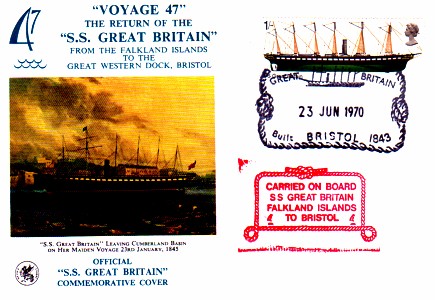
|
|
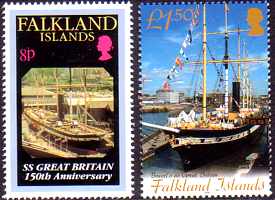
|
Her strong iron hull and double bottom saved her to this day. In the 1960s the British naval architect Dr. Ewan Corlett
drew public attention to the wreck and its historical significance. He founded the "SS Great Britain Project" which
raised the funds to salvage her. In 1970 the hull was lashed onto a pontoon (see stamp above) and towed to Bristol.
Thus "Great Britain" returned to the same place where she was built 125 years before, in the Great Western
Drydock. The ship has since been restored to her original 19th century appearance and is today a maritime museum.
|
|
A letter carried on "Great Britain’s maiden voyage in 1845 from Liverpool to New York; Postage
8 pence paid at Liverpool and 6 cent ship fee charged at New York.
|
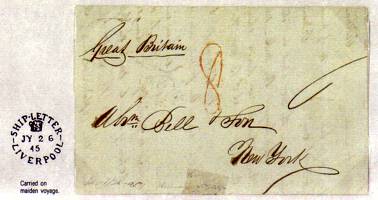
|
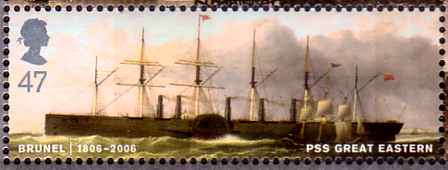
| |
The "Great Eastern" was Isambard Kingdom Brunel’s engineering masterpiece. Not only the largest ship of the era,
she was five decades ahead of her time! Her dimensions were truly gigantic.
"Great Eastern" -- originally named “Leviathan” -- was built to take passengers and emigrants to Australia and to be
suitable as a troop transport. She was designed for large amounts of cargo and a coal capacity sufficient for an entire
round voyage-- ports with coaling depots were rare and expensive at the time. She was intended to surpass the
clipper ships’ dominant position in the Australia trade.
|
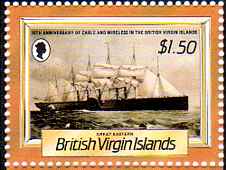
|
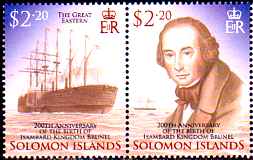
|
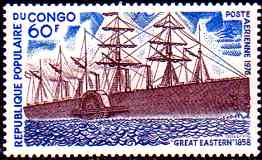
|
Some construction data:
- Built by Scott, Russel & Co. on the Thames at Millwall.
- Keel laid in 1854; launched in 1858 after several unsuccessful attempts.
- L * B * D = 211m * 36m (over the paddle boxes) * 9.2m with 18m height of hull.
- 18,915 GRT; 27,859 tdw.
- Double bottom, double hull, and nine transverse bulkheads.
- A 4,900 HP engine for the single screw of 24 feet in diameter.
- A 3.400 HP driving the paddle wheels of 58 feet diameter.
- Five funnels; six masts with 5,000 square meters auxiliary sails.
- Average speed around 14 knots.
- 800/2,000/1,200 passengers in 1st/2nd/3rd Class.
- Crew around 400 men.
|
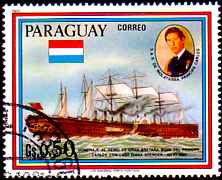
|
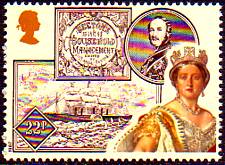
| |
From planning in 1851 to launching in 1858 one misfortune followed another. Workers fell off scaffolding and died,
a riveter and his apprentice disappeared without a trace. Years later, during demolition, human bones were found in
the double bottom. There were cost overruns, building came to a stop, new financing had to be obtained. The launch,
planned sideways due to the ship’s length, ended in disaster -- the hull got stuck. Finally, after four attempts, the ship
was afloat. The Eastern Steam NavigationCo. went bankrupt and sold the unfinished ship to the newly establised
Great Ship Company. The earlier name "Leviathan" was
changed to "Great Eastern".
A boiler exploded on her maiden voyage, resulting in the death of six engineers and injuring many others. The ship's
boat carrying the captain ashore capsized. Captain, bosun, and a decksboy drowned. All this on a maiden voyage
spelt a bad Omen!
|
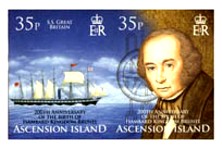
|
Relations between Brunel and the shipyard’s Russell during the construction period were severely strained, involving
financing, building problems, and Russell’s ignoring of Brunel’s instructions. Publicity, Russel blamed all mishaps on
Brunel. Isambard Kingdom fell ill and suffered a stroke. He was unable to participate in the trial runs and died on
September 15, 1859.
|
|
Misfortune continued to plague the ship. On her maiden voyage to New York she had just 38 paying passengers
aboard -- with room for 4000! It was a financial disaster.
A water pipe burst during the homebound voyage spoiling a large amount of provisions. A drive shaft broke, then
"Great Eastern" collided with another vessel. Thus went four years moving passengers, and once serving as a troop
transport to Canada. In 1862 she stranded on an unknown reef off Long Island. Her double bottom saved her from
becoming a total loss.
|
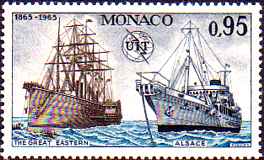
| |
Salvaged and sold once more in 1864, she was converted to a cable layer and in 1865
successfully laid the 2000 miles long transatlantic telegraph cable from Ireland to Newfoundland.
|
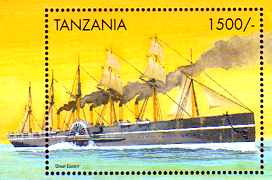
|
In 1867 "Great Eastern" was chartered by a French company intending to bring guests from New York to Brest to visit
the Paris World Exhibition. However, only 191 passengers took passage and the venture ended in a financial loss. Jules
Verne was aboard and later wrote his novel "A Floating City”. Between 1869 and 1875 she laid several more
undersea cables in the Atlantic and Indian Oceans. Afterwards the ship was auctioned off to several successive
owners.
| |
In 1886 the iron ship "Great Eastern" became a floating carnival at the Liverpool World’s Fair, once more in
a money-losing endeavour. Then, there was no further use for this giant vessel. There were purpose-built cable
laying ships, fast express passenger liners, and the opening of the Suez Canal along the way. This extraordinary
vessel, unfortunately a ‘white elephant’ far ahead of her time, was scrapped in 1889 /90.
|
|
Source:
Wikipedia Internet Encyclopaedia
W. Asendorpf, Der große "Leviathan" (The Great Leviathan), Schiffahrt International 2/78
W. Asendorpf, Ein schwimmendes Denkmal für Isambard K. Brunel, die vielen Wandlungen der
"Great Britain" (A Floating Memorial ...), Schiffahrt International 11/81
|
© 1998 - 2006 Bjoern Moritz, all rights reserved.
|